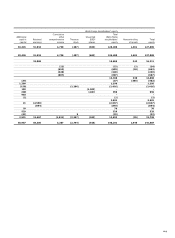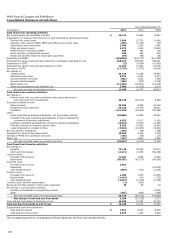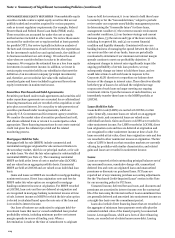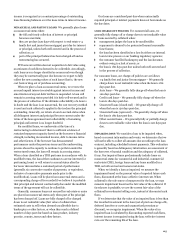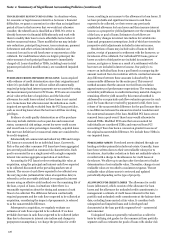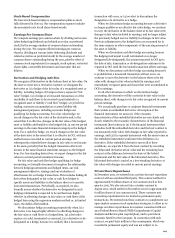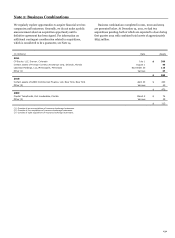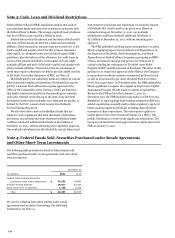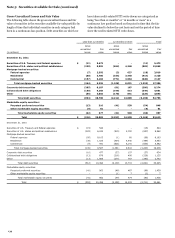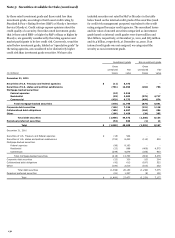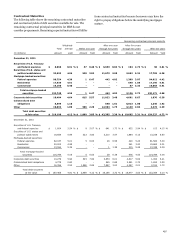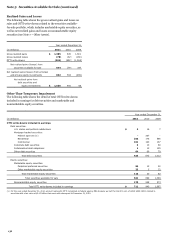Wells Fargo 2011 Annual Report Download - page 130
Download and view the complete annual report
Please find page 130 of the 2011 Wells Fargo annual report below. You can navigate through the pages in the report by either clicking on the pages listed below, or by using the keyword search tool below to find specific information within the annual report.Note 1: Summary of Significant Accounting Policies (continued)
a reporting unit fair value is not less than its carrying amount,
quantitative tests are not required. We have determined that our
reporting units are one level below the operating segments. We
assess goodwill for impairment on a reporting unit level and
apply various quantitative valuation methodologies when
required to compare the estimated fair value to the carrying
value of each reporting unit. Valuation methodologies include
discounted cash flow and earnings multiple approaches. If the
fair value is less than the carrying amount, an additional test is
required to measure the amount of impairment. We recognize
impairment losses as a charge to noninterest expense (unless
related to discontinued operations) and an adjustment to the
carrying value of the goodwill asset. Subsequent reversals of
goodwill impairment are prohibited.
We amortize core deposit and other customer relationship
intangibles on an accelerated basis over useful lives not
exceeding 10 years. We review such intangibles for impairment
whenever events or changes in circumstances indicate that their
carrying amounts may not be recoverable. Impairment is
indicated if the sum of undiscounted estimated future net cash
flows is less than the carrying value of the asset. Impairment is
permanently recognized by writing down the asset to the extent
that the carrying value exceeds the estimated fair value.
Operating Lease Assets
Operating lease rental income for leased assets is recognized in
other income on a straight-line basis over the lease term. Related
depreciation expense is recorded on a straight-line basis over the
estimated useful life, considering the estimated residual value of
the leased asset. The useful life may be adjusted to the term of
the lease depending on our plans for the asset after the lease
term. On a periodic basis, leased assets are reviewed for
impairment. Impairment loss is recognized if the carrying
amount of leased assets exceeds fair value and is not recoverable.
The carrying amount of leased assets is not recoverable if it
exceeds the sum of the undiscounted cash flows expected to
result from the lease payments and the estimated residual value
upon the eventual disposition of the equipment.
Liability for Mortgage Loan Repurchase Losses
We sell residential mortgage loans to various parties, including
(1) Freddie Mac and Fannie Mae (government-sponsored
entities (GSEs)), which include the mortgage loans in GSE-
guaranteed mortgage securitizations, (2) special purpose entities
that issue private label MBS, and (3) other financial institutions
that purchase mortgage loans for investment or private label
securitization. In addition, we pool Federal Housing
Administration (FHA)-insured and Department of Veterans
Affairs (VA)-guaranteed mortgage loans, which back securities
guaranteed by the Government National Mortgage Association
(GNMA).
We may be required to repurchase mortgage loans,
indemnify the securitization trust, investor or insurer, or
reimburse the securitization trust, investor or insurer for credit
losses incurred on loans (collectively “repurchase”) in the event
of a breach of specified contractual representations or warranties
that are not remedied within a period (usually 90 days or less)
after we receive notice of the breach. Our loan sale contracts to
private investors (non-GSE) typically contain an additional
provision where we would only be required to repurchase
securitized loans if a breach is deemed to have a material and
adverse effect on the value of the mortgage loan or to the
investors or interests of security holders in the mortgage loan.
We establish mortgage repurchase liabilities related to
various representations and warranties that reflect
management’s estimate of losses for loans for which we could
have a repurchase obligation, whether or not we currently
service those loans, based on a combination of factors. Such
factors include default expectations, expected investor
repurchase demands (influenced by current and expected
mortgage loan file requests and mortgage insurance rescissions
notices, as well as estimated demand to default and file request
relationships) and appeals success rates (where the investor
rescinds the demand based on a cure of the defect or
acknowledges that the loan satisfies the investor’s applicable
representations and warranties), reimbursement by
correspondent and other third party originators, and projected
loss severity. We establish a liability at the time loans are sold
and continually update our liability estimate during their life.
Although investors may demand repurchase at any time and
there is often a lag from the date of default to the time we receive
a repurchase demand, the majority of repurchase demands occur
on loans that default in the first 24 to 36 months following
origination of the mortgage loan and can vary by investor.
The liability for mortgage loan repurchase losses is included
in other liabilities. For additional information on our repurchase
liability, see Note 9.
Pension Accounting
We account for our defined benefit pension plans using an
actuarial model as more fully discussed in Note 20.
Income Taxes
We file consolidated and separate company federal income tax
returns, foreign tax returns and various combined and separate
company state tax returns.
We evaluate two components of income tax expense: current
and deferred. Current income tax expense approximates taxes to
be paid or refunded for the current period and includes income
tax expense related to our uncertain tax positions. We determine
deferred income taxes using the balance sheet method. Under
this method, the net deferred tax asset or liability is based on the
tax effects of the differences between the book and tax bases of
assets and liabilities, and recognizes enacted changes in tax rates
and laws in the period in which they occur. Deferred income tax
expense results from changes in deferred tax assets and
liabilities between periods. Deferred tax assets are recognized
subject to management's judgment that realization is “more
likely than not.” Uncertain tax positions that meet the more
likely than not recognition threshold are measured to determine
the amount of benefit to recognize. An uncertain tax position is
measured at the largest amount of benefit that management
believes has a greater than 50% likelihood of realization upon
settlement. Foreign taxes paid are generally applied as credits to
reduce federal income taxes payable. We account for interest and
penalties as a component of income tax expense.
128



